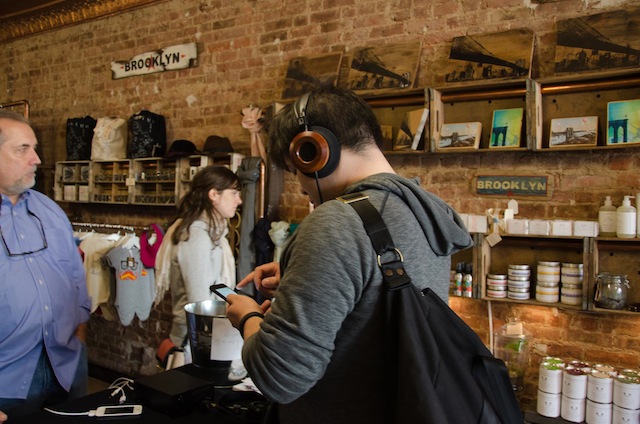
Grado Labs gave audiophiles a chance to check out the sound from its high-end headphones during a Meet & Greet at By Brooklyn in April. Photo Grado Labs
Brooklyn is full of makers and designers responsible for creating more than a few objects that have caught our attention as of late. Some are obscure, others ingenious–all are definitely awesome and left us wondering: Who made that? We’ve decided to start finding out the back story behind some of these inventions, and to share the tales of how they came to be, in a new series on BB. In June, we discussed design plans for a new tool that has the potential to solve all our bike problems and open our beers at the same time. Its $10K Kickstarter campaign is nearing $50,000 with two days left to go, so chances are good its Greenpoint designer Jonathan Sabutis will be filling orders as planned in the fall. Then we took a look at no-muss, removable wallpaper designed by Brooklyn artists like Caitlin Keegan for the company Chasing Paper. This week we decided to delve into one of Brooklyn’s oldest design companies, Grado Labs–they’ve been making headphones that are music to our ears for almost 30 years. It doesn’t get more old school than that.
The design history of Grado headphones goes back much further than the smartphones or mp3 players that most pairs are plugged into these days. To really tell the story of how these headphones came to be the cult audio accessories they are today, we need to take it all the way back to the Sony Walkman. In the ’80s, around the time that the Walkman was introduced, Joe Grado, an audiophile who’d been running a successful business in Sunset Park since 1953, selling his patented phono cartridges–the thing that translates the vibrations of a needle on a turntable into an audio output, i.e. music–decided he’d try his hand at the headphone business.
“The Sony Walkman helped us grow, and then the addition of the Apple iPod grew us even bigger,” says John Chen, Grado’s director of sales and marketing, though he considers himself a “consigliere” for the family-run business . “The reason we got into the headphone business was because Joe Grado was an avid and serious recordist of music, and he found that there was nothing out there of the quality that he needed to make sure that his levels and microphones were in the right position. Thus the headphones were born.”
Before Bose or Beats by Dre, Grado’s was making the coolest cans on the market–but it cost about $2,000 a pop for a pair, so, in the ’90s they introduced a more affordable style, the SR series, which are in the $100 range–there are currently 10 Grado headphone styles in total. By Brooklyn sells Grado’s SR80i style for $99. None of them are cheap but you’re paying for the purest sound you can get in a pair of localized loudspeakers. What differentiates the design from the $5 earbuds you can buy in a bodega is that they are high-fidelity, supra-aural and open-air designed. In translation: They offer the highest quality reproduction of original sounds, surround your ears in super comfy foam and the back of the ear cups are open to let more sound in and out. It’s functionality over fashion with these headphones, though signature design elements on its more expensive styles, like hand-crafted mahogany accents, blur the line between the two. Over the decades, Grado’s has held on to some elements of design that are distinctly ’80s and add to their old school feel, like oversized earcups that could give Princess Leia’s doughnut buns some competition. Other styles are more modern, made with plastic and headpieces finished in leather. In short: They look good, but sound even better.
“That kind of drive, looking for the correct reproduction of the recorded event, was always the goal that’s been instilled in the company since 1953,” says Chen.”It was always about the music.” Grado is privately owned and prefers to remain mum on just how many pairs of headphones it sells per year, but Chen did say the company’s cans are sold by over 300 dealers in the U.S. and in 60 countries around the world. Grado’s doesn’t sell them directly through their site, though you can find sellers by location here.
“It’s musical truth,” Chen says. “We always bear in mind when we design a product to be a bridge to that musical truth. Form follows function, and material science is an important factor, but essentially what we want to do is get people closer to the music.”

